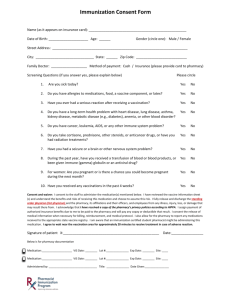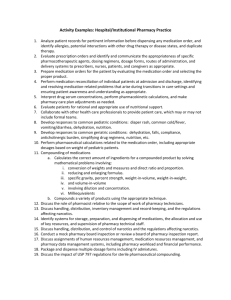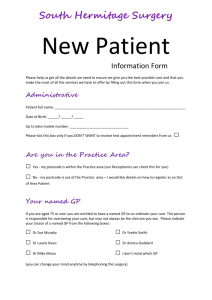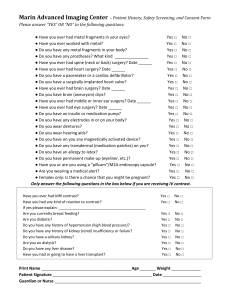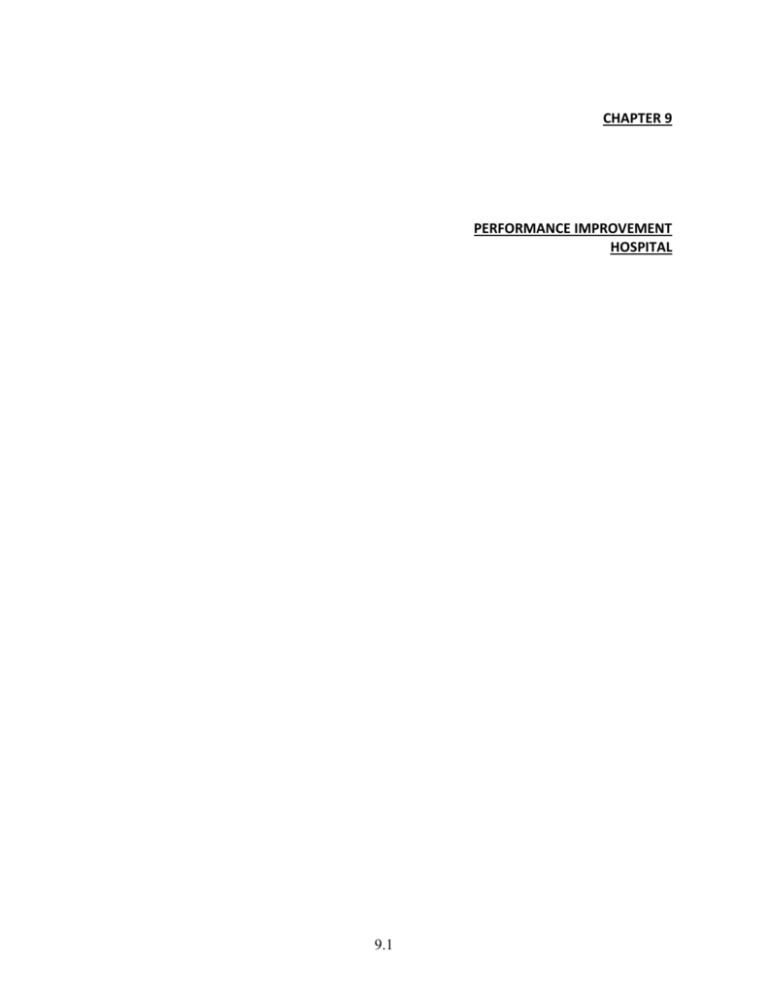
CHAPTER 9
PERFORMANCE IMPROVEMENT
HOSPITAL
9.1
PERFORMANCE IMPROVEMENT
Introduction to terminology and requirements
Performance Improvement (PI)
PI program required by:
o Florida Board of Pharmacy
o The Joint Commission
o Center for Medicaid/Medicare Services (CMS)
Powerful tool
Systematic process
o Example: Plan-Do-Study-Act (PDSA) methodology
Focus on patient safety and optimizing care
Required areas for hospital performance improvement:
Medication Error Detection and Prevention Program
Adverse Drug Reactions
CMS Hospital Core Measures
Medication Use Evaluation (MUE)
Proactive Risk Assessment (FMEA)
External Benchmarking - optional
Medication Error Detection and Prevention Program
Florida Board of Pharmacy
Requirement for Continuous Quality Improvement Program (CQI) to identify qualityrelated events and to improve patient care (64B16-27.300).
Applies to all pharmacy permits
Inappropriate dispensing
o Variation from the prescription (incorrect drug strength, dosage form, patient,
inadequate or incorrect labeling or directions)
o Failure to identify and manage therapy (under or over utilization, duplication,
contraindications, interactions, duration, allergy, or monitoring)
Requires policy and procedure
Quarterly meetings with documentation requirements for 4 years
Includes assessing the impact of staffing levels, work flow, and technical support
9.2
Medicare CoP §482.25 (b) (6) and 482.21 - The hospital must report drug administrative errors,
adverse drug reactions and drug incompatibilities to its hospital-wide QAPI program”.
Definition of medication error and ADR should be broad enough to include “near misses”.
Program should be non-punitive with the focus on the system and not the involved health care
professionals.
The Joint Commission (MM.07.01.03)
The hospital collects data on significant medication errors and significant adverse drug
reactions, adverse events related to moderate or deep sedation or anesthesia, and the
use of blood and blood components.
Root cause analysis (RCA) required for sentinel events.
o Definition: “Unexpected occurrence involving death or serious physical or
psychological injury, or the risk thereof. Serious injury includes loss of limb or
function.”
o Voluntary reporting to The Joint Commission. Includes assessment of human
factors, equipment factors, controllable environmental factors and
uncontrollable external factors, leadership issues such as culture and
communication.
o Commonly identified root causes include medication use (formulary,
storage/control, labeling, ordering, preparing/distributing, administering and/or
patient monitoring) with most having multiple root causes (leadership,
communication, human factors, assessment, information management, physical
environment, continuum of care, care planning, and patient education)
“CODE 15” – state required reporting of significant medical errors. Reported by hospital Risk
Manager. Pharmacy Director involved if medication event.
Adverse Drug Reactions
TJC Standard MM.07.01.03 - The hospital responds to actual or potential adverse drug events,
significant adverse drug reactions, and medication errors. The hospital has a written process
addressing prescriber notification in the event of an adverse drug event, significant adverse
drug reaction, or medication error.
9.3
Hospital Core Measures
The Joint Commission ORYX Core Measures are required to be reported by hospitals
Measurement results posted for public on Hospital Compare website
(www.hospitalcompare.hhs.gov)
Compliance affects hospital reimbursement
Acute Myocardial Infarction (AMI)
Aspirin at Arrival
Aspirin at Discharge
ACE Inhibitor or ARB for Left Ventricular Systolic Dysfunction
Beta Blocker at Arrival
Beta Blocker at Discharge
Fibrinolytic Medication Within 30 Minutes Of Arrival
Percutaneous Coronary Intervention (PCI) Received Within 90 Minutes of Hospital Arrival
Smoking Cessation Advice/Counseling
Heart Failure
Evaluation of Left Ventricular Systolic (LVS) Function
ACE Inhibitor or ARB for Left Ventricular Systolic Dysfunction
Discharge Instructions
Smoking Cessation Advice/Counseling
Pneumonia
Oxygenation Assessment
Pneumococcal Vaccination
Influenza Vaccination
Blood Culture Performed in the Emergency Department Prior to Initial Antibiotic Received in
Hospital
Appropriate Initial Antibiotic Selection
Smoking Cessation Advice/Counseling
Surgical Care Improvement/Surgical Infection Prevention (SCIP)
Prophylactic Antibiotic Received Within 1 Hour Prior to Surgical Incision
Prophylactic Antibiotics Discontinued Within 24 Hours After Surgery End Time
Prophylactic Antibiotic Selection
Appropriate Venous Thromboembolism Prophylaxis started at the right time
Appropriate body temperature
Perinatal Care
Venous Thromboembolism (VTE)
Stroke (STK)
Hospital Based Inpatient Psychiatric Services (HBIPS)
Children's Asthma Care
Mortality
Readmission rates
9.4
External Benchmarking
2014 Quality and Accountability Performance Scorecard
UF Health Shands Hospital
This document presents the measures evaluated in the 2014 UHC Quality and Accountability ranking. This scorecard provides a comparison of your organization's performance with
that of other academic medical centers. The data were obtained from existing UHC data resources, including the Clinical Data Base (Q3 2013 – Q2 2014), Core Measures Data
Base (Q2 2013 – Q1 2014), as well as HCAHPS data from the Hospital Compare Web site (Q4 2012 – Q3 2013) and National Healthcare Safety Network data (Q2 2013 – Q1 2014).
The goal of the Quality and Accountability ranking is to assess organizational performance across a broad spectrum of high-priority dimensions of patient care. The 2014 scoring
and ranking cover the domains of mortality, effectiveness, safety, equity, patient centeredness and efficiency using measures developed by national organizations or the federal
government. Refer to the methodology white paper (available at www.uhc.edu) for specifics regarding the metrics, scoring methods, and data sources used.
Overall Composite Performance
Rating
Overall
(Based on Clinical Domain Performance)
Composite
Score
Top-Performer
Score
Group Median
68.4
76.9
65.7
Clinical Domain
Performance
Rank
(* denotes tie)
Domain
Score
Top-Performer
Score
Group Median
Mortality (25%)
46*
59.4%
85.2%
54.3%
Includes UHC O/E mortality rate for the following selected product service lines: bone marrow transplant, burns, cardiology, cardiothoracic surgery, cardiac surgery, thoracic surgery, gastroenterology, gynecology, gynecologic
oncology, heart/lung transplant, HIV, kidney/pancreas transplant, liver transplant, medical oncology, medicine general, neurology, neurosurgery, obstetrics, orthopedics, otolaryngology, plastic surgery, rheumatology, spinal
surgery, surgical oncology, surgery general, trauma, urology, and vascular surgery.
Effectiveness (25%)
48
83.1%
90.6%
81.9%
Includes all-cause readmission rate within 30 days after discharge and Joint Commission Hospital Core Measures composite scores for AMI, HF, PN, and SCIP (IP and OP), STK, VTE: percentage of patients who received the
care they were eligible to receive; as well as performance on the ED-1b, ED-OP-18b (median time) and IMM-1a and IMM-2 measures.
Safety (25%)
9*
68.8%
73.4%
60.9%
Includes PSI metrics: PSI-03 pressure ulcer, PSI-06 iatrogenic pneumothorax, PSI-09 postoperative hemorrhage or hematoma, PSI-11 postoperative respiratory failure, NHSN metrics: Central Line Associated Blood Stream
Infection, Catheter Associated Urinary Tract Infection, Surgical Site Infection, and Core Measure: VTE-06 venous thromboembolism.
Equity (5%)
88*
91.7%
100.0%
97.9%
Includes Joint Commission Hospital Core Measures composite scores for AMI, HF, PN, SCIP-IP, ED-1b, IMM-1a, IMM-2, STK and VTE, testing for statistically significant differences in outcomes in 3 equity-based dimensions:
gender (male vs. female), race (white vs. nonwhite), and socioeconomic status (Medicaid, self-pay, uninsured, and charity combined vs. all others).
Patient Centeredness (10%)
23*
62.5%
79.7%
56.3%
Includes 10 HCAHPS questions on nurse communication, doctor communication, pain management, communication about medications, cleanliness and quietness, responsiveness of staff, discharge information and overall rating
of the hospital averaged as a composite.
Efficiency (10%)
86
47.7%
70.3%
57.8%
LOS O/E and direct cost O/E for following selected service lines: cardiology, gastroenterology, medical oncology, general medicine, neurology, general surgery, neurosurgery, CT surgery (cardiac surgery and thoracic surgery
combined). Cases within the above service lines with 1 day LOS and an MS-DRG in the following list are excluded: 069, 190, 191, 192, 291, 292, 293, 313, 391, 392, 223, 225, 226, 227, 242, 243, 244, 245, 246, 248, 249, 251,
259, 261 and 262.
© 2014 University HealthSystem Consortium. All rights reserved. NOTICE: This document contains proprietary information that is confidential and protected by state and federal privacy and peer review laws. Any unauthorized
copying of this document is forbidden
9.5
Medication Use Evaluation (MUE)
The Joint Commission specifies data may be collected retrospectively or prospectively
Focus on specific drug or treatment
Target drug, drug class, or disease MUE based on high risk, high volume, problem
prone, new formulary item, or request from health care practitioner
1. Prescribing examples:
a. Appropriate use of vancomycin with goal to reduce resistance and drug related
morbidity
b. Appropriate dosage of drugs
i. Adjustment for renal function
ii. Adjustment for patient weight
c. Appropriate order writing
i. PRN orders have clear indication for use
ii. No dangerous abbreviations
2. Dispensing examples:
a. Turnaround time for STAT orders
b. Accuracy of dispensing
c. Appropriate auxiliary labels
i. Storage requirements: refrigerate, do not refrigerate
ii. Expiration dating
iii. Special precautions such as hazardous handling, do not shake
3. Administration examples
a. Patient education about medications
b. Appropriate use of infusion pumps
c. Compliance with giving medications on time
d. eMAR scanning rates
e. Arm band checks
4. Monitoring examples:
a. INR is assessed prior to administration of warfarin
b. Pain assessment and reassessment for pain medications
c. Incidence of hypoglycemia or hyperglycemia
Proactive risk assessment
Required by The Joint Commission and Medicare COP (§482.25 (b) (6)).
Used to prioritize performance improvement efforts.
The assessment should include medication errors, adverse drug reactions, and the
medication management system (MM 08.01.01).
An accepted methodology involves Failure Mode and Effects Analysis (FMEA) requires
clarifying the process (e.g., flow chart), assigning severity and risk scores to each
process. The scores are used to prioritize performance improvement.
9.6
64B16-27.300 Standards of Practice - Continuous Quality Improvement Program.
(1) “Continuous Quality Improvement Program” means a system of standards and procedures to identify and
evaluate quality-related events and improve patient care.
(2) “Quality-Related Event” means the inappropriate dispensing or administration of a prescribed medication
including:
(a) A variation from the prescriber’s prescription order, including, but not limited to:
1. Incorrect drug;
2. Incorrect drug strength;
3. Incorrect dosage form;
4. Incorrect patient; or
5. Inadequate or incorrect packaging, labeling, or directions.
(b) A failure to identify and manage:
1. Over-utilization or under-utilization;
2. Therapeutic duplication;
3. Drug-disease contraindications;
4. Drug-drug interactions;
5. Incorrect drug dosage or duration of drug treatment;
6. Drug-allergy interactions; or
7. Clinical abuse/misuse.
(3)(a) Each pharmacy shall establish a Continuous Quality Improvement Program which program shall be
described in the pharmacy’s policy and procedure manual and, at a minimum shall contain:
1. Provisions for a Continuous Quality Improvement Committee that may be comprised of staff members of
the pharmacy, including pharmacists, registered pharmacy interns, registered pharmacy technicians, clerical staff,
and other personnel deemed necessary by the prescription department manager or the consultant pharmacist of
record;
2. Provisions for the prescription department manager or the consultant pharmacist of record to ensure that
the committee conducts a review of Quality Related Events at least every three months.
3. A planned process to record, measure, assess, and improve the quality of patient care; and
4. The procedure for reviewing Quality Related Events.
(b) As a component of its Continuous Quality Improvement Program, each pharmacy shall assure that,
following a Quality-Related Event, all reasonably necessary steps have been taken to remedy any problem for the
patient.
(c) At a minimum, the review shall consider the effects on quality of the pharmacy system due to staffing
levels, workflow, and technological support.
(4) Each Quality-Related Event that occurs, or is alleged to have occurred, as the result of activities in a
pharmacy, shall be documented in a written record or computer database created solely for that purpose. The
Quality-Related Event shall be initially documented by the pharmacist to whom it is described, and it shall be
recorded on the same day of its having been described to the pharmacist. Documentation of a Quality-Related
Event shall include a description of the event that is sufficient to permit categorization and analysis of the event.
Pharmacists shall maintain such records at least until the event has been considered by the committee and
incorporated in the summary required in subsection (5) below.
(5) Records maintained as a component of a pharmacy Continuous Quality Improvement Program are
confidential under the provisions of Section 766.101, F.S. In order to determine compliance the Department may
review the policy and procedures and a Summarization of Quality-Related Events. The summarization document
shall analyze remedial measures undertaken following a Quality-Related Event. No patient name or employee
name shall be included in this summarization. The summarization shall be maintained for two years. Records are
considered peer-review documents and are not subject to discovery in civil litigation or administrative actions.
Rulemaking Authority 465.0155 FS. Law Implemented 465.0155 FS. History–New 7-15-99, Amended 1-2-02, 6-1603, 11-18-07, 1-1-10.
9.7
9.8
PDSA: Plan-Do-Study-Act
Also called: Rapid Cycle Improvement, PDCA (Plan-Do-Check-Act)
What is PDSA?
PDSA, or Plan-Do-Study-Act, is an iterative, four-stage problem-solving model
used for improving a process or carrying out change.
When using the PDSA cycle, it's important to include internal and external
customers; they can provide feedback about what works and what doesn't. The
customer defines quality, so it would make sense to also involve them in the
process when appropriate or feasible, to increase acceptance of the end result. (If
you're unsure about, who your customers are, you may want to create a
customer chain to assist in identification.)
In applying PDSA, ask yourself three questions:
1.
What are we trying to accomplish?
2.
How will we know that a change is an improvement?
3.
What changes can we make that will result in an improvement?
Stage 1: Plan
A. Recruit Team
Assemble a team that has knowledge of the problem or opportunity for improvement.
Consider the strengths each team member brings—look for engaged, forward-thinking staff.
After recruiting team members, identify roles and responsibilities, set timelines, and establish a meeting schedule.
B. Draft an Aim Statement
Describe what you want to accomplish in an Aim Statement (QI Toolbox: Aim Statement
). Try to answer those three
fundamental questions:
1.
What are we trying to accomplish?
2.
How will we know that a change is an improvement?
3.
What change can we make that will result in improvement?
rev. 03/ 2014
1
9.9


